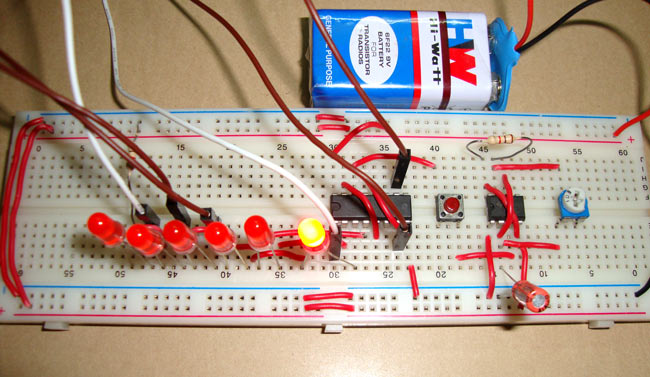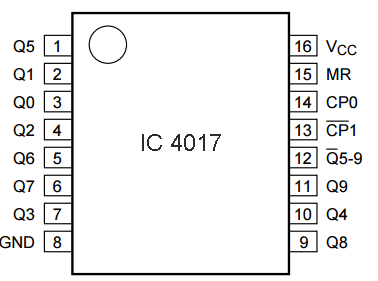
Dice is used to play many games like snake ladder, Ludo etc. Generally dice is made up of wooden or plastic, which gets deformed with time and become biased. A Digital dice is a good alternative of old fashioned dice, it can’t be biased or deformed. It operates at such high speed that no one can cheat. To create this digital dice circuit, we have mainly used 555 timer IC and 4017 IC. You can also check this digital dice circuit using Arduino.
4017 IC
4017 IC is a CMOS decade counter chip. It can produce output at the 10 pins (Q0 – Q9) sequentially, means it produce output one by one at the 10 output pins. This output is controlled through the clock pulse at PIN 14. At first, output at Q0 (PIN 3) is HIGH, then with each clock pulse, output advance to the next PIN. Like one clock pulse makes the Q0 LOW and Q1 HIGH, and then the next clock pulse makes the Q1 LOW and Q2 HIGH, and so on. After the Q9, it will start from the Q0 again. So it creates sequential ON and OFF of all the 10 OUTPUT PINs. Below is the PIN diagram and PIN description of 4017:

|
PIN NO. |
PIN Name |
PIN Description |
|
1 |
Q5 |
Output 5: Goes high in 5 clock pulse |
|
2 |
Q1 |
Output 1: Goes high in 1 clock pulse |
|
3 |
Q0 |
Output 0: Goes high at the beginning – 0 clock pulse |
|
4 |
Q2 |
Output 2: Goes high in 2 clock pulse |
|
5 |
Q6 |
Output 6: Goes high in 6 clock pulse |
|
6 |
Q7 |
Output 7: Goes high in 7clock pulse |
|
7 |
Q3 |
Output 3: Goes high in 3 clock pulse |
|
8 |
GND |
Ground PIN |
|
9 |
Q8 |
Output 8: Goes high in 8 clock pulse |
|
10 |
Q4 |
Output 4: Goes high in 4 clock pulse |
|
11 |
Q9 |
Output 9: Goes high in 9 clock pulse |
|
12 |
CO –Carry out |
Used to cascade another 4017 IC to makes it count upto 20, it is divide by 10 output PIN |
|
13 |
CLOCK inhibit |
Clock enable pin, should kept LOW, keeping HIGH will freeze the output. |
|
14 |
CLOCK |
Clock input, for sequentially HIGH the output pins from PIN 3 TO PIN 11 |
|
15 |
RESET |
Active high pin, should be LOW for normal operation, setting HIGH will reset the IC (only Pin 3 remain HIGH) |
|
16 |
VDD |
Power supply PIN (5-12v) |
Components
- CD4017 IC
- 555 Timer IC
- 2 Resistor- 1k
- Capacitor- 10uF
- Variable Resistor- 10K
- Push Button
- 6 LEDs
- Battery - 9v
Circuit Diagram and Explanation
In this digital dice circuit we have used 6 LEDs, each LED represent a number (1-6) of Dice. LEDs start flashing as we press the Push button and stops when we release it. After release, illuminated LED tells the numbers, you got on Dice. Like if fifth no. LED remains ON after releasing the button, means you got 5 on Dice. We have connected 6 LEDs to the output Q0 to Q5, and the seventh output Q6 is connected back to the RESET PIN 15. So that after LED 6 it starts from the First LED at Q0.
To apply the clock pulse at PIN 14 of 4017 IC, we have used 555 timer IC in Astable mode. The oscillated output generated at PIN 3 of 555 has been applied to the PIN 14 of 4017, so that output can be advanced with each clock pulse. We can control the speed of flashing LEDs by using the potentiometer (RV1), rotating the potentiometer knob will change oscillation frequency of 555 timer, hence the rate of clock pulse. The frequency of the 555 can be calculated using this formula: F=1.44/((R1+2*RV1)*C1)
In this digital dice circuit we have kept the oscillation frequency so high that no one can cheat. LED flashing speed is directly proportional to oscillation frequency of 555, as High the frequency, as high the speed of flashing. You can increase frequency according to you, by rotating the potentiometer.
Comments
Digital dice by 7segment display
I want to know the circuit diagram of digital dice by using 7segment display. please send to my mail. Thanks!







How can I control the resistance by remote? Please reply.